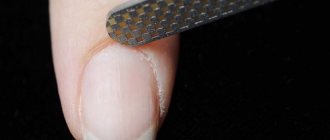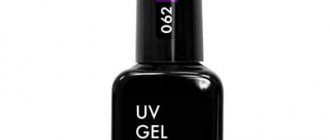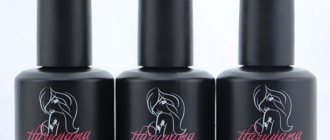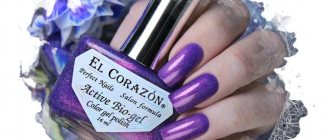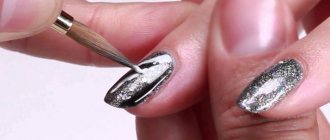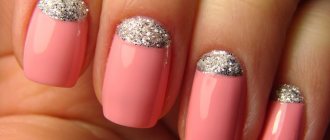Coating features
The word “camouflage” came to us from the French language, translated from which it means “camouflage”. We used to call camouflage the spotted green-brown clothing worn by the military. Many people think that camouflage polish is also green, but this is a misconception. Camouflage gel is a coating that was invented to mask an imperfect nail plate or artificially lengthen it. These polishes come in different shades, but they are all natural and as close as possible to the skin tone: peach, nude, pinkish. There is also a transparent camouflage polish, but it is used either to create a French manicure or to strengthen your own nails. Surprisingly, the texture of the coating after hardening looks the same as a regular nail. Therefore, it is not always possible to distinguish a natural nail plate from an artificial one. But such a result can be achieved if the work is done efficiently. If there are bumps or chips on the nail, air bubbles are visible, or the artificial layer peels off, then this manicure definitely does not look like a natural one.
What is camouflage gel for?
At first, this type of varnish was used only to create a French manicure, but now it has begun to perform other functions. Camouflage polish is needed to hide the imperfections of the nail and make it shiny and perfectly smooth. Under a viscous coating you can hide scratches, irregularities, white spots, bumps and other flaws in the nail plate. If your natural nails are not shiny, have a yellowish or grayish tint, they can be coated with a pinkish or peach-colored varnish, and then they will become shiny. By the way, this color of nails may indicate a lack of vitamins or some disease. Perhaps this problem needs to be solved medically, and not hidden under a polymer coating. This varnish also solves the eternal problem of the vast majority of girls - brittle nails. Many representatives of the fair sex try to grow their nails long, but few succeed. And here – two hours of work by the master, and the girl becomes the owner of long, ideally shaped nails. Camouflage coating is often used as a therapeutic agent. If your nails need to be revived after removing gel polish, you can use transparent “camouflage”. It strengthens the plate and, importantly, allows air to pass through.
Application technology
You can get a manicure using gel both in a beauty salon and at home if you have the necessary materials. This procedure is absolutely simple if you follow all the steps and listen to the advice of professionals. Necessary tools include a UV lamp for drying, camouflage gel, brushes, a form (for the first extension), nail files, base coat, degreaser and topcoat. But before you start applying, you need to do a hygienic manicure, disinfect all tools and remove the cuticle.
The gel application procedure consists of several stages:
- prepare the plate, treat it with a degreaser, apply a base coat, which should be dried in a lamp for 1 minute;
- if you use a form to build a nail, then you need to remove the adhesive part and attach it to each finger;
- if the extension procedure is not happening for the first time, then its use is absolutely not necessary;
- apply a small amount of gel to the brush and distribute evenly over the entire plate, it is recommended to start from the center and move to the edges;
- put your hand in an ultraviolet lamp for 1-2 minutes;
- after drying, proceed to the next nail until all the plates of one hand are covered;
- once all fingers are covered with gel, put them in the lamp for one minute for a more durable result;
- after this you can proceed to the next hand;
- Once all fingers are covered with camouflage nail gel, the molds can be removed to build the plate;
- then a top coat is applied, which must be dried in a lamp, and then you can do a French manicure or leave your nails natural.
UV camouflage gel runail how to use
Today, not every woman can boast of perfect nails that have an even color and correct shape.
However, you should not despair about this, because there is a way out of this situation.
This could be artificial nail extensions using a special gel.
To give the nail plate a natural shade, simply apply camouflage nail gel to it. Based on its properties, this product is classified as a series of colored gels.
This is explained by the fact that it can be used both as a sculptural material and as a strengthening material due to the many different pigments it contains.
The palette of the presented gel includes all natural pink and beige colors.
Therefore, nail extensions using this gel is a very relevant procedure, because thanks to this product you can create the effect of a natural, even nail coating.
You need to know that this gel is usually divided into three types:
Nail extension with camouflage gel
The most popular among clients is single-phase camouflage gel , which is easy to file, convenient to use and provides better adhesion to the surface of the nail plate.
In addition, its method of application does not present any particular difficulties. It is enough to apply the primer to a previously degreased nail.
Next you need to follow the layers:
- base thin layer - forms the outline of the future nail, lays out the natural nail and shape;
- constructor - creates a structure, covers defects.
The applied layers must be dried under an ultraviolet lamp for 2 minutes if the lamp power is 36 W.
When choosing a gel, you need to pay attention to the manufacturer.
Today, Runeil camouflage gel .
It perfectly hides minor defects in the nail plate, gives it a more natural look and lengthens the nail bed.
This gel is valued by many experts for its average viscosity and rich color palette, represented by all natural shades of pink and beige.
It is also ideal for French manicure.
VIDEO ON THE TOPIC » alt=»»>
Nail preparation
Before the strengthening procedure, nails must be treated, which, firstly, will allow you to perform a high-quality manicure, and secondly, will provide your hands with a well-groomed, aesthetic appearance. Experts distinguish three main types of manicure: classic (edged), European (unedged), hardware.
A classic manicure involves removing the cuticle with special nippers, where it is first moved back and then removed. Before the hand procedure, it is recommended to take a bath, which will soften rough skin and simplify the entire manicure process.
European manicure involves removing nail polish using a special softening agent - remover. The procedure goes as follows: first the remover is applied, and after a while the softened cuticle is moved with an orange stick.
Hardware manicure is the most gentle; it not only removes the cuticle, but also gives the plates the desired shape. Such a device can be bought in specialized stores; it includes all the necessary attachments and instructions for use.
Next, give the nails the desired shape: square, almond-shaped, rounded or sharp. In this case, it is recommended to move the file in one direction, so the plates are less injured. To ensure that the gel adheres well, the nails are treated with a soft buff; however, you should not overdo it; the plate should not be too thin.
The last step in preparing the nails is degreasing them with a special composition; this procedure will also help the gel to firmly take hold. After removing excess shine, the nail plates should not be touched. If biogel is used for the strengthening procedure, then experts do not recommend sanding the nails with a buff; it is enough to just degrease them.
Three phases of application
There are three types of camouflage varnishes available today:
- single-phase;
- two-phase;
- three-phase.
Each of these types has its own characteristics and indications for use. The choice depends on what problem you need to solve. If the original nail is strong and without defects, then a more liquid varnish is needed. If there are unevenness and other flaws on the nail plate, a very thick and dense coating is used. The choice of varnish type also depends on whether there will be some kind of design on the nail.
Single phase
This composition is especially popular in the fashion world. Single-phase varnish is a three-in-one coating: at the same time it is a base, color and finishing layer. Instead of several compounds, only this gel is applied to the nail. Nail technicians often choose this type of camouflage polish because it is very easy to apply and makes touch-ups easy. It has a dense texture, but at the same time it is flexible. Using this polymer you can make nails of any shape and length. The single-phase composition dries very quickly, so the procedure itself does not take much time. The palette of tones of this type of varnish is varied, so you can easily choose a coating for any skin tone.
Two-phase
This varnish is not as thick as single-phase varnish. It is applied in several layers. In this case, the next layer is placed only after the previous one has completely dried. To make your nails long and thin, the layers should also be thin. If you do not follow this rule, the gel may soon peel off or cracks will appear on its surface. A manicure with this polish takes longer.
Three-phase
To achieve the desired effect and get beautiful long nails that look like natural ones, the coating is applied in three layers. First, the base layer is applied, then the sculpting layer, and then the finishing layer. The structure of this coating is very liquid, so it is easy to apply. But there is also a drawback - three-phase varnish bubbles a lot. Therefore, an experienced master who can cover the nail perfectly without bubbles or unevenness should work with it. In order for the extended nail to be durable, it must be coated with single-phase varnish at the end.
Final stage
Then the dispersion layer is removed. Using a nail file, the master gives the free edge a beautiful shape. The dust is thoroughly cleaned with a brush. Then the nail plate is degreased.
After this, camouflage gel for French manicure is applied with an angled brush. This is done in two layers, each of which is dried under a lamp for two minutes.
At the end of the procedure, the master applies a finishing layer with a sticky dispersion layer, spreading it over the entire nail. Then the nails are dried again in the lamp for two minutes.
After the allotted time, the master removes the form. Now he selects a shade from the color palette that best matches the natural color of the nail plate and completes the extension.
Strengthening nails with gel. Instructions
Strengthening nails under gel polish using gel can be done with a single-phase or three-phase agent. If the product is single-phase, then only this gel is applied to the prepared nail plates; if it is three-phase, then three different products are used: base, constructor and finish.
Experts also pay attention to other necessary conditions:
- In order for the gel coating to last longer, it is not recommended to use any moisturizer on the skin of the hands before the procedure;
- if a bath was made before processing the plates, then it is better to carry out the strengthening procedure the next day;
- An additional product – a rubber base – will help achieve a perfectly flat surface;
- To avoid chips and cracks, at each stage of strengthening it is necessary to carefully seal the end of the marigold.
The most important thing is that for the result to be pleasing to the eye, and for the manicure to last at least 3 weeks, you should complete the following three mandatory steps.
Step 1: base
Base is a transparent material from which the strengthening procedure begins. Apply the product with a thick synthetic brush in a thin layer. Dry the base in a lamp, the exposure time is from 30 s to 1 min (this depends on the quality of the lamps used and the manufacturer of the material).
If a single-phase product is used, then the gel is also applied in a thin layer and dried in a lamp.
Step 2: Base Layer
When the base has dried, they begin to work with the main layer, it is also called construction or sculpture. Since strengthening does not involve the process of changing the shape and length of the nail, the product is applied quite densely, but not in a greasy layer.
Instructions for strengthening nails with gel under gel polish in photo
In this case, the gel should not be attached to the cuticle and side ridges, which can subsequently lead to peeling and chipping of the material. If the product does get on areas close to the nail, it should be removed with a cotton swab dipped in a degreaser. Drying the sculpture layer in a lamp.
Step 3: Finish
Top Coat is the last, final layer. Before applying it, you need to make sure that the previous layers lay flat; if this is not the case, then you should make a sawdust of the unevenly distributed material with a soft buffer. The finish is applied with the same dense synthetic brush and polymerized in a lamp. The final touch is to remove the sticky layer (if there is one) with a special napkin.
The procedure is completed by applying gel polish or other coating. When choosing gel polish, do not forget about the top coat, which will allow the product to last much longer.
Camouflage Features
The structure of the material in terms of density is very similar to the structure of a natural nail, so after the extension procedure, artificial nails are difficult to distinguish from real ones. The main advantage of camouflage material is that the polymer composition allows natural fabrics to breathe under layers of manicure. It does not cause irritating reactions and also prevents the appearance of fungal formations.
The polymer fills the damaged or deformed area of the plate, creating a perfectly smooth surface and the most favorable conditions for nail restoration. You can also correct the architecture of your nails with gel.
Varieties
After the appearance of this product, manufacturers began to produce several varieties of gel. Thanks to this, a classification based on application technology appeared. Before purchasing this cosmetic product, you need to familiarize yourself with the features of each type and choose the most suitable one.
Varieties of camouflage nail gel include:
- Single stage system. The name speaks for itself and indicates the number of steps that must be completed during application. This system is distinguished by its versatility and is quite often used as a base, topcoat and corrective agent. Thanks to the presence of polymers in the composition, the nail plate becomes smooth and shiny. It takes about five minutes to dry completely, and the girls do not have any difficulties during filing.
- Two-phase – it is aimed at strengthening the natural nail. Professional manicurists note that this camouflage gel system comes in different thicknesses and is used by highly qualified specialists. It significantly improves the appearance and quality of the design after visiting the salon.
- Three-phase. An even more complex system of application technology. Due to the rather liquid consistency, oxygen bubbles may appear throughout the surface when used. But this gel is extremely durable against chips and cracks. And it can even withstand numerous impacts on hard surfaces.
Design Variations
To make a natural manicure, you can use a camouflage polish in one of the following colors:
- Ivory;
- peach;
- beige;
- pink;
- light pink.
But you can come up with a more interesting design. To do this, you can add acrylic powder of any shade to the transparent base. By the way, she can do not only natural tones. For an original manicure, you can use red, black, gray powder. Its presence turns the glossy coating into a matte one, and the camouflage varnish looks different. So, to make a military nail design, you can add dark green powder to the composition. This varnish is ideal for creating a French coat. The nail plate is extended to the required length and its edge is painted white. If your nails are short or long but brittle, then you won’t be able to create a French manicure without camouflage. To create a real French manicure, you need to use a clear camouflage polish. But if you add a little peach or pink powder to it, the color will turn out very delicate. This option is ideal for a wedding look.
With this versatile product you can bring your wildest ideas to life. So, on a long, completely transparent nail, designs made of bright shiny stones will look beautiful. You can also apply glitter and any patterns on it. But still, natural beauty is in trend, so nails extended in this way are rarely decorated. Sometimes you can play with shades. Nail specialists advise owners of fair skin, for example, to opt for a transparent or cool-toned varnish. This subdued color palette is also suitable for winter manicure. Ivory and beige colors suit white-skinned beauties. And in the summer it is better for them to choose soft peach or other warm shades of nail polish.
But dark-skinned girls can use it all year round. For skin with a reddish tint, pink or pale pink is suitable.
Glitter Camouflage
Camouflage can be made shiny. This is an unusual mixture of bold and formal style, with shiny materials that make the design festive. It’s worth experimenting with glitter to find the right fraction and color.
Advantages and disadvantages
Manicure with camouflage gel is in great demand in beauty salons around the world. Thanks to the many positive aspects of this procedure. They are as follows:
- strengthens the nail plate;
- stimulates rapid growth;
- helps to increase the desired length;
- the effect lasts for a month;
- the procedure is quite quick and easy;
- eliminates the need to use decorative coating;
- protects against the formation of pathogenic microorganisms that cause fungal diseases;
- levels the surface;
- does not interfere with air circulation.
At the same time, manicure has a number of disadvantages. Namely:
- the plate rejects the gel coating in many women;
- contributes to nail damage;
- needs proper removal to prevent unwanted consequences;
- if a chip or crack occurs, the camouflage gel must be reapplied;
- if the coating is done in a beauty salon, then you will need to visit it once a month and pay a certain amount of financial resources.
What is it for?
First of all, this product contains various colored pigments, which distinguishes it from a standard gel. It is aimed at strengthening the nail plate, helping to increase the length and give the manicure a well-groomed and beautiful look. Camouflage gel is great for creating a French design, as it does not require the additional use of a decorative coating.
You may be interested in: Manicure “Pink Marble”: fashion news, design ideas, photos
The application technology is practically no different from the colorless product, but has some individual features. Unlike acrylic, gel coating is considered safer, since it does not interfere with the penetration and circulation of air, and also does not contribute to the development of fungal diseases. Camouflage nail gel is in demand among professional manicurists, as well as among girls when building and strengthening plates at home. They highlight many advantages, but what attracts them to a greater extent is the variety of shades that allow you to choose a color that matches your natural color.
What is a camouflage base for nails, what is it for, how to choose it?
Such a product appeared in the nail art industry relatively recently, a little later than the first gel polish or shellac. Just 5-7 years ago, extended nails, which were lengthened using gel or acrylic, were quite popular. Nowadays, naturalness, nude manicure and classics are at the peak of popularity, so many girls have given up having their nails done and are doing a manicure with gel polish, while strengthening the nail plate with a base.
What to do if you want to get a French manicure and you have natural nails with a short nail bed? How to lengthen the nail bed and hide the ugly color of the plate? Many girls get out of this situation by using regular gel polish in beige or pink shades. But the fact is that such a coating does not look very beautiful, because a French manicure should be as natural as possible.
Camouflage base
Advantages and areas of use of the camouflage base:
- Regular gel polish is quite highly pigmented, so it completely covers the nail plate. When it grows back, the regrown part of the nail is quite clearly visible. Many manufacturers have found a way out of such situations and have created camouflage bases especially for manicurists, as well as girls who adore classic French manicure.
- The product is nothing more than a regular nail base with the addition of a small amount of pigment. Accordingly, the surface of the nail is tinted, acquiring a pastel, natural shade, but the coating itself is translucent. It helps eliminate minor defects and hide the blue or yellow tint of the nails.
- Accordingly, with this base you can not only paint your nails, but also improve the adhesion of the natural nail to the artificial material, that is, gel polish, and perform leveling. The properties of camouflage are absolutely the same as those of a regular, transparent base for applying gel polish. Only it differs in its color.
- Now many companies sell a variety of bases; they can be white, milky, cream, or pinkish. Black and white bases are also available. This greatly simplifies the application of rubs, or in the case when a base is needed for a manicure. That is, in such cases when a magnetic design, volumetric inlay or lace manicure is used.
- The most popular are camouflage bases in beige and nude shades to create a French manicure, the popular French gradient or Baby Boomer design.
- It is worth noting that the camouflage base can be used both to improve the adhesion of a natural nail to gel polish, and for leveling . In this case, you can even perform drip leveling, when a large drop is placed on the nail, distributed to the free edge and to the cuticle, then the nail is turned over to form a beautiful apex, and dried in a lamp.
- Many manicurists have noted that a camouflage base is ideal if you use stained glass or light translucent, slightly pigmented varnishes. In this case, the design seems brighter and richer. At the same time, the natural nail does not show through, which helps save time and the number of layers of application. Even lightly pigmented varnishes need to be applied to a camouflage base in a maximum of two layers.
Camouflage base and jacket
How to remove artificial material
The material in question cannot simply be removed with nail polish remover. Experts recommend filing off the gel; a glass or metal file with notches will not work; it is better to use a buffer with an abrasiveness of 100–150 grit, designed specifically for artificial materials.
You need to file off the gel coating carefully so as not to hurt the natural nail. The dust generated during the procedure should be periodically brushed off and the nails moistened with liquid, then the layer of artificial material and natural coating will be clearly visible.
Cleaned nails are sanded and polished, and the surface is treated with a moisturizing component. The final touch is the application of a strengthening base.
If biogel was used as a base for gel polish to strengthen nails, it is removed with a special product or regular acetone. Cotton pads are soaked in the existing liquid, applied to the nails and wrapped in foil for 15–20 minutes. When the material dissolves, it is carefully removed with tweezers. The plates are then polished and lubricated with a nutrient.
You can strengthen natural nail plates with the help of modern materials - gel or biogel. The procedure can be carried out both in the salon and at home, the main thing is to follow the instructions exactly, then beautiful nails will delight you for at least 3 weeks.
Popular brands of camouflage gel polishes
bluesky
Bluesky offers the widest selection of camouflage shades, about 30. This camouflage is mainly used as a base for gel polish and a camouflage coating when making a jacket. The Bluesky rubber coating is harmless to the nail plate, and its durability allows you to wear a manicure for up to 3 weeks.
Shellac bluesky
Among Bluesky's single-phase gel polishes there are also camouflage tones.
Haruyama
The Japanese brand Haruyama is convenient for fashionistas who want to save time and money on gel polish manicures. Haruyama allows the use of his camouflages as a single-phase gel polish. You will need to sacrifice a thin layer of your nail for cutting. The color palette of Haruyama is less diverse than that of Bluesky camouflage gel polishes.
Gel polishes HARUYAMA / HARUYAMA
There are 12 camouflage shades available for order in Haruyama online stores. The ease of application of Haruyama is complemented by the high quality of the coating. This combination of qualities has ensured the high popularity of Haruyama camouflage gel polishes for home use. An additional advantage of Haruyama gel polishes is their affordable price.
Rubber camouflage
TNL offers a Rubber camouflage line of 10 rubber-based tones. TNL recommends applying varnish to the base coat. Among the single-phase TNL varnishes there are also camouflage shades.
Naomi Rubber Comouflage gel polish base
The quality of this 3-in-1 TNL coating is inferior in quality to rubber camouflage, but significantly saves time. The colors of single-phase TNL are noticeably more saturated than rubber ones. When applying a jacket, it is preferable to choose TNL Rubber camouflage.
Cody
The manufacturer Kodi positions its products as professional; there is no offer of single-phase varnishes on the official website. Cody's camouflage tones are presented as part of the main gel polish palette.
When choosing camouflage gel polish, it is important to understand the pattern: gentle, useful coatings require additional time and patience to apply. Single-phase gel polishes simplify and speed up the manicure process, but have a negative effect on the nail plate.
Gel-varnish Codi
According to customer reviews, many do not see a problem with small changes in the surface of the nails, since they will grow back in any case. Some people uncompromisingly protect the quality of their own nails. Before purchasing, determine your own priorities: safety of the coating or speed.
Disadvantages of camouflage gel
Like any product, camouflage gel has its drawbacks, which must be taken into account before carrying out the extension procedure.
All extension products can cause allergies. Camouflage gel polish is no exception. Before going to the salon to see a specialist, consult your doctor and make sure there are no contraindications.
Under the influence of an ultraviolet lamp, the “native” nail plate may deteriorate: the nail will be damaged, microburns or cracks will occur. In addition, in order to remove the extended layer, you will have to file everything down, and if the technician is unqualified, this can lead to injury to the nail plate.
Camouflage nail gel has a significant drawback: if the nail breaks or gives even the slightest crack, it is necessary to file everything down to the root.
After extensions, you need to visit a specialist every three weeks to correct your nails.
Another disadvantage is the high cost of extensions using camouflage gel.
Camouflage properties
Initially, the product was created for the correction of natural nail plates and their lengthening during artificial manicure. The material lay down so smoothly and held firmly that the craftsmen began to think about whether it was possible to extend nails with camouflage gel . The first experiments confirmed the suitable properties and decent results:
- the extended plates look almost like “native” ones;
- the growing nail is masked for a long time and the free edge is covered;
- the extension technique is available to those with nails with a small, irregularly shaped bed;
- effective camouflage gel for strengthening and smoothing nails ;
- it contains antifungal and antiseptic substances;
- The frozen camouflage gel allows air to pass through: the nails “breathe”, the metabolic processes of the nail bed and the replenishment of the plate are not disrupted.
It retains its presentable appearance almost until the coating is removed, and this manicure is worn for at least 3 weeks. True, a strong build-up with camouflage gel can only be removed by cutting off the coating. But for this there are soft cutters and gentle technologies that protect the structure of the natural plate.

